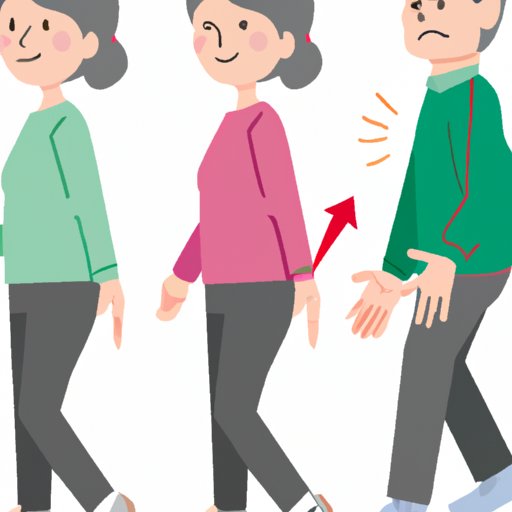Exploring the anatomy and muscles used in walking for overall health and well-being
Walking is one of the most basic forms of human movement. It is a fundamental part of our daily lives and necessary for our overall health and well-being. Yet, walking might seem like an effortless activity. Most of us do not realize the complexity of muscles used when taking a walk. In reality, walking relies on a complex interplay of muscles, bones, and joints in our body. Understanding the anatomy and muscles involved during walking can help us develop exercises and injury prevention routines to maintain our level of mobility and balance. In this article, we explore the anatomy of walking, the muscles involved, the benefits of brisk walking, injury prevention, and its effect on seniors’ mobility.
Walking Anatomy
At its core, walking is a repetitive cycle of shifting weight from one foot to the other. Humans have evolved to walk on two legs, which requires an intricate web of muscles to maintain balance and coordination during every step. During walking, different muscle groups are activated depending on various factors, such as walking speed, terrain, footwear, and posture.
The main muscle groups involved in walking are the glutes, quadriceps, hamstrings, and calves. These muscle groups work in harmony to create upward and forward movements while maintaining balance and stability. The glutes are primarily responsible for hip extension, which is necessary for propelling the body forward during every step. The quadriceps are the largest muscle group in the body and play a crucial role in knee extension during each step. The hamstrings located in the back of the thigh are responsible for knee flexion and hip extension. Finally, the calves or the gastrocnemius and soleus muscles in the lower leg help with ankle movement.
Other muscle groups are also involved in walking, including the hip flexors, tibialis anterior, and intrinsic foot muscles. The hip flexors assist in lifting the leg while taking a step, while the tibialis anterior helps in raising the foot off the ground. The intrinsic foot muscles, located in the bottom of the foot, help maintain balance and stability during walking.
Fitness Focused Anatomy
Brisk walking, a more intense form of walking, is an excellent low-impact form of exercise that has many benefits for overall fitness. It has a positive impact on cardiovascular health, weight management, and mental health. Walking more briskly also requires additional muscles to be activated compared to slow walking. Brisk walking activates the glutes, quadriceps, hamstrings, and calves simultaneously and creates a higher demand for oxygen for the body to maintain the walk.
Exercises that strengthen muscles used in brisk walking include calf raises, lunges, squats, and glute bridges. Another excellent exercise is walking hills, which requires more energy and involves additional muscles to move the body uphill while maintaining balance. Adding resistance training, such as using resistance bands or weights, can also help strengthen these muscle groups.
Injury prevention
Walking is considered a low-impact activity, and the risk of injury is significantly lower than other high-impact activities. However, walking may still cause injuries such as plantar fasciitis, Achilles tendonitis, and shin splints. These injuries may result from overuse, poor posture, and inadequate footwear.
To prevent injuries, it is important to strengthen the supporting muscles around the affected areas. Exercises and stretches that focus on strengthening the calves, hamstrings, and feet can help prevent injuries such as shin splints and plantar fasciitis. Stretching exercises that focus on the Achilles tendon, hip flexors, and quadriceps can also relieve tightness and reduce the risk of injury.
An Article for Seniors
Seniors face unique challenges when it comes to mobility and balance. Age-related changes such as decreased bone density, weakened muscles, and decreased joint flexibility, may affect seniors’ gait patterns. Muscles that are essential for balance and mobility, such as the glutes, become weaker as we age, which can further exacerbate balance and mobility issues.
Exercises that work on balance, coordination, and mobility are essential for seniors. Exercises such as walking on uneven surfaces, standing on one foot, and heel-to-toe walking can help improve balance. Squats and lunges can help strengthen key muscles while stretching exercises can improve joint flexibility and range of motion.
Holistic Health
Walking is an excellent form of low-impact exercise that not only has physical benefits but also promotes positive mental health. Walking can foster mindfulness and a mind-body connection. Walking in natural environments has been shown to reduce symptoms of depression and anxiety, and improve mood and self-esteem.
Walking can also help with stress management by promoting relaxation and releasing endorphins. It is also an ideal activity for mindfulness – being present in the moment as you move your body. Walking mindfully can help you reframe the present moment and become more aware of your own body. This awareness of your body can extend over time to other aspects of self-care, such as nutrition and sleep hygiene, helping you to lead a more holistic lifestyle.
Conclusion
Walking is an excellent low-impact form of exercise that promotes overall health and wellbeing. Understanding the muscles used for walking, the benefits of brisk walking, injury prevention, exercises for seniors, and its wider holistic health benefits can help you maintain your mobility and balance while enjoying the great outdoors. Whether you’re a senior looking to stay active, an active person wanting to improve their fitness level, or just want to enjoy mindfulness and the benefits that walking brings, it is easy to integrate walking into your daily routine.
